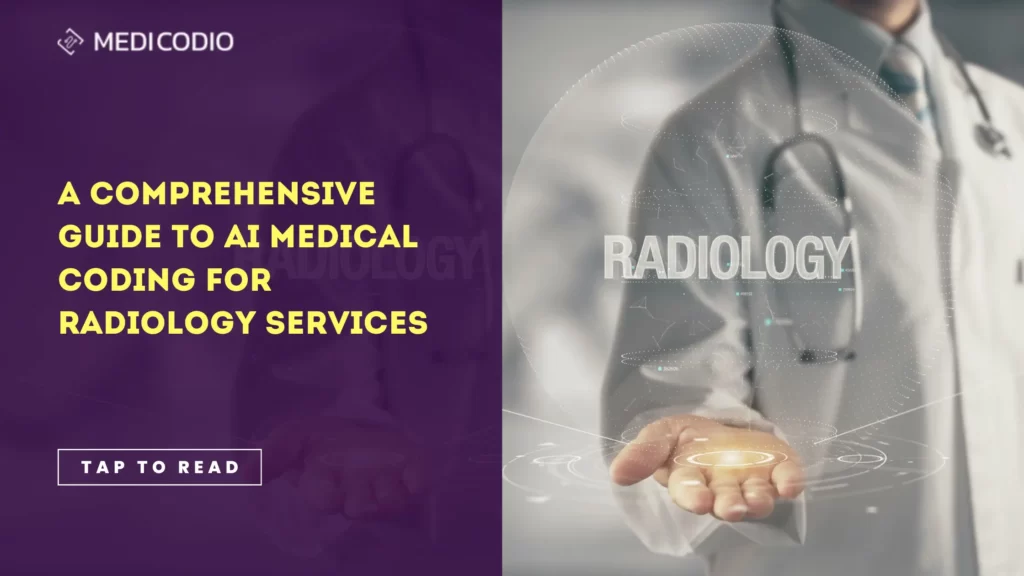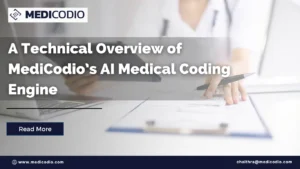For healthcare and RCM professionals, medical coding is an important process because the results can make or break their revenue. Especially in the radiology space, medical billing, coding, and managing receivables can be a daunting endeavor for busy radiology practices. While coding for radiology services, medical coders may encounter a number of issues such as unbundling, incorrect use of modifiers, incorrect units of service, missing/incorrect add-on procedure codes, and so on.
This guide aims to help medical professionals accurately assign codes and bill for radiology services, ensuring proper reimbursement and efficient healthcare administration.
Embark on a journey to master medical coding for radiology services with this comprehensive guide.
Typically, most diagnostic reports comprise the following details:
- Patient Information: Basic details like the patient’s name, age, gender, and sometimes their medical record number or ID.
- Study Description: Describes the type of imaging test done, such as X-ray, MRI, CT scan, ultrasound, etc. It may also specify the body part or area that was scanned.
- Technique Used: Explains how the test was performed, including details like the type of machine used, any contrast material or dye given, and positions the patient was asked to be in during the test.
- Findings: Describes what the radiologist sees in the images. For example, it might say if there are any abnormalities, fractures, tumors, inflammation, or other issues in the body part scanned.
- Impressions/Conclusion: Summarizes the important findings and may offer a diagnosis or possible explanation of what the findings could mean. It might suggest further tests or follow-up actions are needed.
- Recommendations: Sometimes included, this section suggests what the next steps should be, such as seeing a specialist, getting additional tests, or starting specific treatments.
Medical Coding for Radiology Services
Medical coding is a crucial aspect linked to diagnostic radiology reports. When a radiologist generates a report detailing the findings and observations from imaging tests, these reports often need to be translated into codes for billing, insurance claims, and medical records. Here’s how it connects:
- ICD (International Classification of Diseases) Codes: These codes describe diagnoses based on the findings in the radiology report. For instance, if the report notes a fracture, tumor, or any other specific condition, the corresponding ICD code(s) will be assigned to accurately represent these conditions in the patient’s medical record.
- CPT (Current Procedural Terminology) Codes: These codes represent the procedures or services performed during the imaging test. They cover aspects like the type of imaging procedure (X-ray, MRI, CT scan, etc.), whether contrast material was used, and other technical details of the imaging process.
- HCPCS (Healthcare Common Procedure Coding System) Codes: These codes are used for services not covered by CPT codes, such as medical equipment, supplies, or other services related to the radiology procedure.
Examples of Radiology CPT coding
The American Medical Association maintains the medical code set for Radiology Procedures 70010-79999 under the Current Procedural Terminology (CPT) code range.
- Diagnostic Radiology (Diagnostic Imaging) – (70010 – 76499)
- Diagnostic Ultrasound – (76506 – 76999)
- Radiologic Guidance – (77001 – 77022)
- Breast Mammography – (77046 – 77067)
- Bone/Joint Studies – (77071 – 77086)
- Radiation Oncology – (77261 – 77799)
- Nuclear Medicine – (78012 – 79999)
The Role of AI Medical Coding for Radiology
Radiology, a crucial component of modern healthcare, heavily relies on accurately documenting and coding medical procedures and diagnoses for billing, insurance claims, and patient records. Traditionally, this process was highly manual and time-consuming, often prone to errors due to the complex nature of medical coding. However, with the advent of AI-powered tools like MediCodio, this landscape is undergoing a transformative change.
MediCodio utilizes cutting-edge AI algorithms and machine learning techniques to analyze medical documentation and radiology reports, automatically assigning the appropriate diagnostic codes and procedural information. Its ability to understand and interpret complex medical terminology and nuances in radiology reports enables it to generate accurate codes swiftly, significantly reducing the time spent on coding tasks.
One of the primary advantages of AI medical coding tools like MediCodio is their remarkable accuracy. These tools are trained on vast amounts of data, continuously learning and improving their coding accuracy over time. As a result, they can identify and code diagnoses and procedures with a high level of precision, minimizing errors that could otherwise lead to claim denials or reimbursement delays.
Efficiency is another key benefit offered by AI medical coding tools in radiology services. By automating the coding process, these tools streamline workflow, allowing healthcare professionals to focus more on patient care rather than spending excessive time on administrative tasks. The quick turnaround time for coding also facilitates faster billing cycles, leading to improved revenue streams for healthcare facilities.
Moreover, the implementation of AI coding tools like MediCodio contributes to cost savings for healthcare providers. By reducing manual labor and the potential for errors, these tools optimize resources and minimize the need for additional manpower dedicated solely to coding tasks. This translates into increased operational efficiency and reduced overhead costs for healthcare organizations.
The impact of AI medical coding tools on radiology services extends beyond operational enhancements. The speed and accuracy of these tools enable faster and more precise diagnoses, ultimately benefiting patients by ensuring timely treatments and interventions. Additionally, the standardized and consistent coding facilitated by AI tools enhances data analytics, supporting research, and facilitating better healthcare outcomes.
In conclusion, AI medical coding tools like MediCodio are playing a significant role in revolutionizing radiology services. Their ability to enhance accuracy, efficiency, cost-effectiveness, and overall quality of care underscores their importance in modern healthcare. As technology continues to advance, these AI-driven solutions will undoubtedly continue to transform and optimize the landscape of radiology services, ultimately benefiting both healthcare providers and patients alike.





